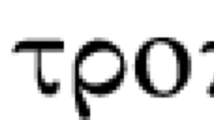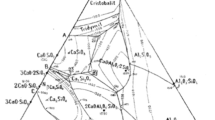Abstract
It is a fundamental cornerstone of thermodynamics that entropy (\(S_{U,V}\)) increases in spontaneous processes in isolated systems (often called closed or thermally closed systems when the transfer of energy as work is considered to be negligible) and achieves a maximum when the system reaches equilibrium. But with a different sign convention entropy could just as well be said to decrease to a minimum in spontaneous constant U, V processes. It would then change in the same direction as the thermodynamic potentials in spontaneous processes. This article discusses but does not advocate such a change.


Similar content being viewed by others
Notes
It is often said that entropy increases in every irreversible process if the environment of the system is included as part of the system, though when the environment is the rest of the universe, as it often is, this is questionable. Cosmologists are still debating the entropy of the universe (Carroll 2010).
References
Anderson, G.M., Crerar, D.A.: Thermodynamics in Geochemistry, p. 588. Oxford University Press, Oxford (1993)
Carroll, Sean: From Eternity to Here: The Quest for the Ultimate Theory of Time. Dutton, New York (2010)
Clausius, R.: The mechanical theory of heat with its applications to the steam engine and to the physical properties of bodies. 1 paternoster row: john van voorst, London. Translated and with an introduction by Professor John Tyndall. A collection of nine Memoirs on the Mechanical Theory of Heat published between 1850 and 1865 (1867)
Denbigh, K.: The Principles of Chemical Equilibrium: with Applications in Chemistry and Chemical Engineering. Cambridge University Press: Cambridge. pp 1-10 (1966)
Jones, J.B., Dugan, R.E.: Engineering Thermodynamics. Prentice Hall Inc, Englewood Cliffs, New Jersey (1996)
Klotz, I.M.: Chemical Thermodynamics. W.A. Benjamin Inc New York With advice and suggestions from Thomas Fraser Young (1964)
Lewis, R.N., Randell, M.: Thermodynamics and the Free Energy of Chemical Substances, 1st edn. McGraw Hill, New York (1923)
Moore, W.J.: Physical Chemistry, 3rd edn. Prentice-Hall Inc, New Jersey (1962)
Prigogine, I., Defay, R.: Chemical Thermodynamics Translation of the 1950 edition by D.H. Everett. Longmans Green: London (1954)
Reiss, H.: Methods of Thermodynamics. Blaisdell, New York (1965)
Acknowledgements
I thank Norm Evensen for many useful discussions on this and other thermodynamic topics, Karyn and Brendan Bradley Gorra for help with the figures, and Grant Garven for encouraging me to persist after several journal rejections with no peer review.
Author information
Authors and Affiliations
Corresponding author
Additional information
Publisher's Note
Springer Nature remains neutral with regard to jurisdictional claims in published maps and institutional affiliations.
Rights and permissions
Springer Nature or its licensor (e.g. a society or other partner) holds exclusive rights to this article under a publishing agreement with the author(s) or other rightsholder(s); author self-archiving of the accepted manuscript version of this article is solely governed by the terms of such publishing agreement and applicable law.
About this article
Cite this article
Anderson, G.M. Entropy and sign conventions. Found Chem 25, 119–125 (2023). https://doi.org/10.1007/s10698-022-09463-6
Accepted:
Published:
Issue Date:
DOI: https://doi.org/10.1007/s10698-022-09463-6




